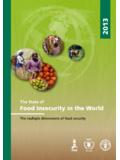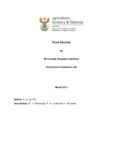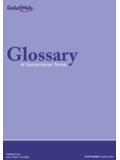Transcription of World Health Organization Health Action in Crises …
1 World Health Organization Health Action in Crises Ethiopia Strategy Paper Situation analysis Ethiopia has a total population of 71,1 million (2004)1 and is one of the poorest countries in the World , with a per capita annual income of US$ 90 (2003). Ethiopia is experiencing recurrent problems as a result of droughts and conflicts. Drought has become a chronic occurrence, affecting the country peri-odically (once every 7 10 years) since 1983. The current drought is only exasperating the needs re-sulting from the 2003 drought, leaving presently 3,8 million people in desperate need for emergency food relief and another million chronically food insecure assisted through a productive safety net program.
2 The incidence of certain diseases increases during droughts. The main diseases most commonly en-countered are: malaria, diarrhea, intestinal helminthiasis, acute respiratory infections including pneu-monia, tuberculosis and skin diseases. Outbreaks of meningitis, measles and diarrhoeal diseases including cholera are also common during droughts. Periodically, the dry lands experience heavy seasonal rains, which cause flooding leading to internal displacement and increased risk for diseases related to stagnant waters such as malaria and cholera. The widespread food shortages associated with these natural disasters further results in malnutrition and under-nutrition.
3 In order to address chronic poverty and persisting food insecurity, the Ethiopian government is since 2003 conducting a massive resettlement programme, under which 2,2 million people will be moved to more productive areas. 1 Health and Health related Indicators, 2003/04 FMOH Ethiopia 2 May 2005 Ethiopia is currently hosting some 124,000 refugees from Sudan, Somalia and Eritrea. While there are no official numbers of internally displaced persons, it is estimated that about 168,000 persons have been displaced by conflict and ethnic tension. Refugees and displaced people are especially vulner-able from a Health perspective because of their living conditions and reduced access to Health ser-vices.
4 It is imperative that the Health sector is prepared to meet the additional Health burden resulting from natural disasters and man-made emergencies. One of the steps in this regard is for WHO to support Ministry of Health capacity to make nutritional and Health needs assessments among vulnerable groups. The other step is to build the required Health care services. Additional logistics may also be required to assist the implementation of the programmes in times of emergency and disaster. Mecha-nisms of monitoring of the nutritional status of children as well as the impact of interventions (nutri-tional surveillance system) need to be put in place.
5 In May, a flash update to the Joint Humanitarian Appeal for 2005 was released due the rapidly deterio-rating humanitarian conditions in Ethiopia. While the food needs require an additional $65 million to be met, the non-food needs (including Health and nutrition) fall short of $105 million. Health Status Malaria: In Ethiopia, almost 75% of the land is malarious and an estimated 51 million (68%) of the population lives in areas at-risk of malaria. Malaria is still the leading cause of Health problem in the country. In 2004, the disease has been reported as the first cause of illness and death accounting for of outpatient visits, of admissions and 27% of deaths.
6 The magnitude and periodicity of malaria epidemics in the country has also been on the rise in the past few years. Some 5,4 million cases of epidemic malaria cases are expected in 20052. HIV/AIDS/STI: The HIV/AIDS prevalence rate among adults is 4,4% (2003), ranging between 0,4%-7,3% across the country. Given Ethiopia's large population, this means that up to 2,3 million people may be living with HIV/AIDS. The rapid spread of the HIV infection poses a major challenge to the Health and other sectors of the country. Tuberculosis: In 2001, about 93,000 new cases of tuberculosis were reported, with a death rate of 7% among sputum smear-positive cases.
7 With the advent of HIV/AIDS, the prevalence of TB has been increasing. In 2004 the numbers of new cases reported were 117,861while the estimated incidence is around 262,944 The DOTS strategy is being implemented in most districts, and almost all hospitals and Health services provide DOTS services. However, basic Health services are only accessible to about 64% of the population1. Meningitis: Situated in the African "meningitis belt", Ethiopia is in the dry season struck regularly by outbreaks of meningococcal disease. While difficult to predict the intervals between outbreaks, 3,2 mil-lion people are considered to be at risk in 2005. Poliomyelitis: In December 2004, one case of polio was confirmed in the Tigray region linked to the polio outbreak in Sudan in May 2004.
8 Since then, till April 2005 thirteen additional cases have been reported in the north of the country. Ethiopia has been polio-free since 2001. Reproductive Health : Ethiopia has a maternal mortality rate of 871 per 100,000 live births, and an in-fant mortality rate of per 1,000 live births (2004)1. The identified causes of maternal mortality are mechanic dystocia, eclampsia (high blood pressure during pregnancy), bleeding and sepsis following abortion or delivery. Mothers in drought affected areas find themselves at increased risk due to stress poor nutritional status, poor sanitation and limited access to Health services and essential drugs. Blindness: According to the National Plan for Eye Care in Ethiopia (MOH 2001), the estimated preva-lence rate of blindness is With appropriate public Health measures, two-thirds of these cases could be prevented.
9 They could be due to trachoma, vitamin A deficiency and cataract. According to 2 In 1995, there were 1,1 million cases. 3 May 2005 the Health and Health -related indicator of MOH (2000 2001), cataracts were responsible for of all admissions to hospitals in 2001. Noncommunicable diseases: The prevalence of noncommunicable diseases, including hypertension, cardiovascular diseases and diabetes mellitus, is increasing with changes in people s lifestyles. Ac-cording to the Health and Health -related indicators of MOH (2000 2001), hypertension was the sev-enth leading cause of death in the country in 2001.
10 Mental Health : Mental illness is one of the Health issues that has not received the attention it de-serves. Health workers do recognize that mental illness is on the increase and the government and partners recently commissioned an assessment of the situation. The result, which is believed to serve as background information for the formulation of strategies for addressing mental Health , is being awaited. The Health System Ethiopia is a federal state, divided into nine National Regional States and the two Administrative City Councils: (a) National Regional States: Tigray; Afar; Amhara; Oromia; Somalia; Benishangul-Gumuz; Southern Nations, Nationalities and Peoples Region (SNNPR); Gambella; and Harari; (b) Administrative City Councils: Addis Ababa; and Dire Dawa.














